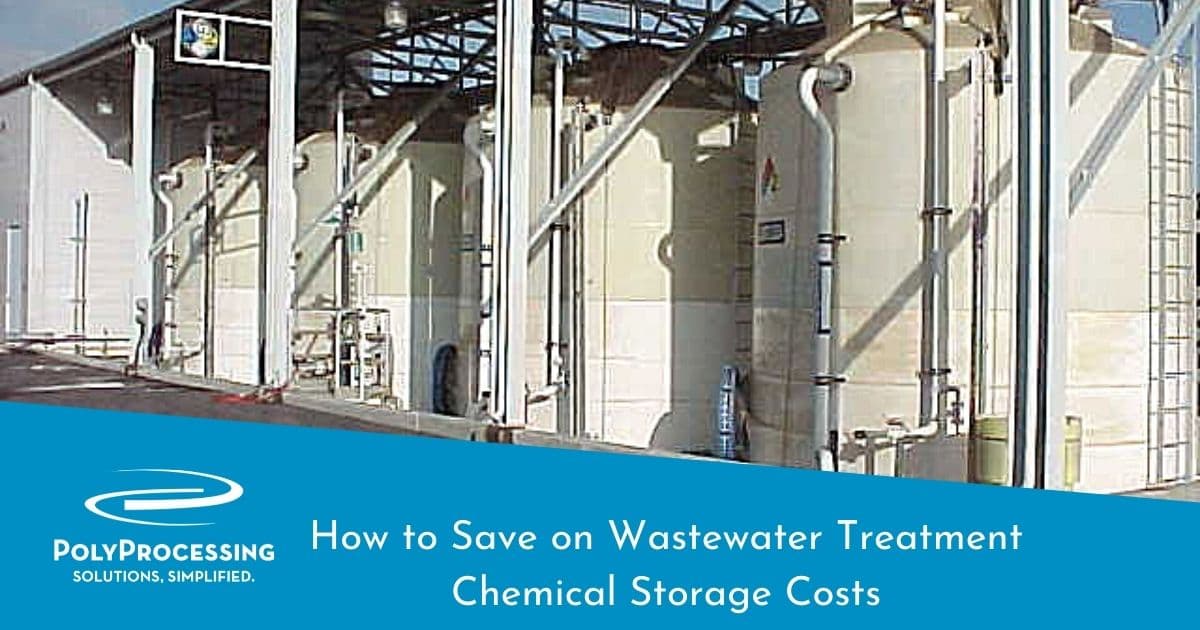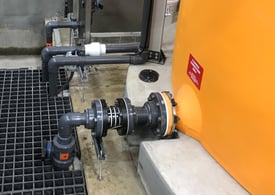How to Save on Wastewater Treatment Chemical Storage Costs
It comes as no surprise that a new wastewater treatment plant can cost hundreds of millions of dollars. Upgrading a plant can cost several million dollars as well. Yet, the chemical storage tanks that go into those plants are one of the least expensive items.

As a result, the need for chemical storage often is overlooked or added on at the last minute, sometimes with little thought and planning. Project planners know they’ll need a tank, but more time is invested elsewhere—on the pumps or mixers, or other equipment.
And that can be a significant problem.
Chemical Storage Is a Priority for Wastewater Treatment
All too often, wastewater treatment facility planners can make late-game decisions about chemical storage because they mistakenly equate cost with importance. As a result, they end up choosing a tank that fits the already-designed floor space, rather than designing a tank for their specific needs and planning a space around that. The result is a non-ideal storage solution that negatively impacts the functioning of the wastewater treatment plant.
Although chemical storage tanks make up a small percentage of the cost of a wastewater treatment facility, they count for a significant portion of its importance. A chemical tank is one of the most important systems in a treatment plant because if the tank fails or stops functioning, there will be no chemicals for the facility. All the pumps and other equipment will also stop functioning because they won’t have any chemicals for operation.
Another reason project planners end up with non-ideal tank solutions is based on budget. You want to cut costs wherever you can. At Poly Processing, we understand the need for smart spending. That’s why we’ll make sure you get the greatest value for your dollar.
Get the Best Chemical Storage for Your Dollar
The goal of every treatment plant project should be achieving the greatest useful life possible for the money you spend. We build each chemical tank system for the particular chemical being stored, and for the specific application. This helps give our customers the greatest useful life and performance out of their chemical storage tanks.
Our tanks are designed for specific uses, chemicals, and industries to increase your tank’s longevity and performance. You’ll get everything you need and nothing you don’t—which means you aren’t paying for features that don’t fit your requirements.
For wastewater treatment applications, we offer three innovative tank solutions to address your needs.

1. IMFO® or Sloped Bottom IMFO®
Tank maintenance can be a challenge with many chemicals. That’s why we developed the Integrally Molded Flanged Outlet® or IMFO system to minimize the hazards of traditional maintenance. With the IMFO system, the flange location is at the bottom sidewall of the tank for full discharge. Because it’s molded as an integral component of the tank, it eliminates stress and almost all opportunities for leaks at the flange.
The Sloped Bottom IMFO Tank offers additional benefits. The tank floor is sloped, providing complete full discharge below the tank knuckle radius, which eliminates the need to enter the tank for cleaning. The Sloped Bottom IMFO allows even heavier materials such as sludge, FOG, and thicker chemicals to discharge completely.
2. SAFE-Tank®
Our SAFE-Tank is a crosslinked polyethylene double wall containment system. This “tank-within-a-tank” keeps contaminants secure in the case of a leak, avoiding the damaging of equipment, loss of chemical, or injury to employees in the event of a spill. It also keeps the interstitial space dry so that rainwater will not set off leak detectors.
3. OR-1000™
Poly Processing’s OR-1000 system is specifically designed to address the aggressive oxidation effects of chemicals like sodium hypochlorite, sulfuric acid, and hydrochloric acid and to extend the useful life of the tank system. The OR-1000 system consists of engineered resins for these specific applications. This system increases the life of a crosslinked polyethylene tank, giving you a greater cost effective solution.
OR-1000’s engineered inner surface is made of polyethylene, specifically formulated to resist oxidation. Its outer surface is made of XLPE for superior strength. The two surfaces are molecularly bonded together during the rotomolding manufacturing process, creating a truly seamless bond between the XLPE and OR-1000 system.
We know that some chemicals can be in tight supply due to shipping backlogs and other manufacturing issues. To mitigate the issues that a shortage can create, many facilities are stocking up on the chemicals they need while they’re still available. If you don’t have backup tanks to store a surplus of chemicals, now might be the time to invest in additional storage tanks.
In many cases, delivery lead times are getting extended. When your primary tank is close to empty, your supplier may not be able to fill it up as quickly as normal. Having a second tank as a backup can provide assurance that you’re covered when you need to be.
We want you to know that we are here to support your efforts by supplying you with high-performance tanks enabling you to stock-up when your supplier has availability. Poly Processing can help you solve your chemical storage challenges and help you manage your risk.
Poly Processing understands the unique needs of wastewater treatment facilities, and we can provide maximum performance and useful life while keeping the tank systems cost effective.
Find out more about how we can make your facility more effective—download our wastewater chemical storage guide.
- September 27, 2021
- Topics: Applications
About Poly Processing
Posts By Topic
Tech Talk Podcast Episodes
Subscribe By Email
Recent Posts
- The Best of 2025 - Top 5 Chemical Storage Blogs
- Installation Tips for Chemical Storage Tanks: Site Preparation and Offloading
- Understanding pH and Chemical Concentration When Choosing a Chemical Tank
- Maximizing Fill Efficiency: Selecting the Optimal Fill Line System
- Chemical Storage Tanks: A Quick Guide for End Users
Tank Configurator

Find the recommended tank and system components for your chemical storage challenge.
Configure a Tank Package







